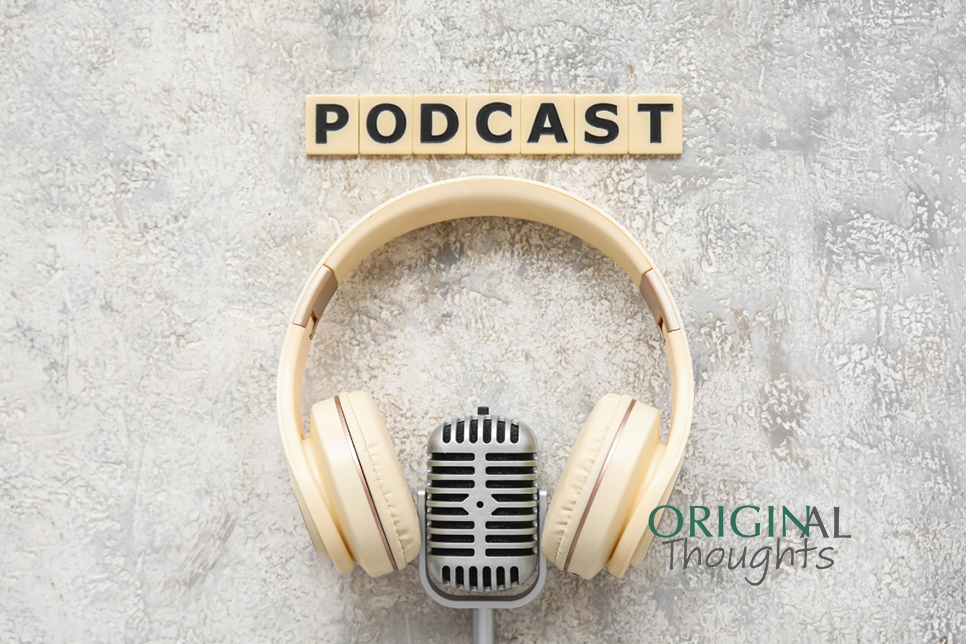Blog post
With Pod on Our Side: Using Podcasts to Drive Journal Engagement
12 Nov 2024

First posted on the ORIGINal Thoughts Blog

Director of Publications, Sales, and Social Media
American Congress of Rehabilitation Medicine
LinkedIn: https://www.linkedin.com/in/glenncollins858/
Take Home Points:
- Podcasts are a popular format that can be used to promote your journal.
- An important step in the development of a podcast program is to determine your budget and your format.
- A podcast should be part of a larger author experience plan to promote their work and persuade them to submit to your journal again and again.
The scholarly publishing landscape is nothing if not challenging these days. Open access policies are in flux, leaving everyone guessing. AI, paper mills, and increasing awareness of ethical issues require more work from the editorial office. Social media, in some instances, seems to be plateauing. Is your journal’s X account picking up new, real followers compared to when you started it years ago? If you don’t pay on Facebook, do your posts get noticed? In the meantime, more journals are in the Web of Science, leading to more options for authors and more competition for journals. There is so much noise and distraction in an industry that is tipping more towards quantity over quality. It can be difficult to differentiate your journal from the rest to attract the best papers that drive usage and citations. One answer might be in offering something that isn’t the journal at all: podcasts.
Podcasts continue to grow in popularity and statistics are startling.
- Over 414 million podcasts exist globally.
- The market is currently valued at $23.56 billion, reflecting the industry’s robust expansion.
- Around 1 in 4 Internet users listen to podcasts.
- Sixty-six percent of consumers today prefer podcasts over TV.
- By 2023, there were over 464 million podcast listeners worldwide, projected to reach 504.9 million by 2024.
The podcast format can address several concerns at once and is tailor-made to deliver author and user engagement, quality discussion, and coverage of the field. It also can serve to bring the journal to where people are in their daily lives—i.e., on their phones, listening to their air pods, consuming content while exercising, or doing something else. The format is also, relatively speaking, inexpensive.
In the scholarly publishing space, a podcast does not need to contain all sorts of bells and whistles nor have an expensive production budget to be successful. I will address first the product itself and then the promotion and ultimately the goals and sustainability.
Product
In its most basic format, a podcast is a person or people talking, and therefore is an effective modality for researchers who wish to disseminate their work to as broad an audience as possible. To leverage the podcast format, the top priority is having a good host or hosts. Not just any person can do this. The most brilliant and respected researcher in the field may not be the most effective communicator. A good podcast host is going to be a lot like a good journalist—a good communicator who can engage many different personality types, is good at the details so they can read a new piece of research and break it down to what is important and what is new, and can discuss it with the authors of the piece as well as with others in the field. The host will have ideas on what type of show to produce but the goal should be showcasing the work published in the journal.
Showcasing the work can take several forms, be it a single host discussing an article or articles (obviously the simplest model), a one-on-one interview with the lead author, a roundtable discussion with several authors, or a roundtable discussion with other experts discussing the work in the journal. The show can also incorporate all of these elements by having interviews and discussions. Examples of these formats are all around us in the many news and sports shows we see every day.
It is important to note that the host does not need to be an editor for the journal, though it may make for a better show to incorporate the editors into the format.
It is also worth noting that even as I write this post there is a new version of a podcast that doesn’t involve a person at all. Google’s NotebookLM allows a user to upload an article and it will produce an audio file that sounds like two people discussing the paper with an amazing level of detail and realism. As with many things in scholarly publishing and the world at large, AI has the potential to completely disrupt the norm. In fact, this article may have a rather short lifespan. The more I listen to the podcast created by NotebookLM the more amazed I am. However, it doesn’t mean you just use the tool and throw everything else away. Any AI product needs human oversight.
There are two other roles here worth noting. Like many media productions with many moving parts, you will need a point person or producer. Identifying articles to discuss, scheduling interviews and promotion, and keeping things on track are all key to this endeavor. The managing editor of the journal is well-positioned for the role, but it could be anyone.
Another role to consider is the engineer. Unless your host is also capable of taking the raw files and editing them into a final format, which may include removing pauses, umms and ahhs, making smooth transitions, and adjusting for overall sound quality, this role could be critical. They will also know how to deliver the final show to the platforms and set up your metrics.
When working with your host, you will want to decide on a format (20 minutes, 30 minutes, interviews, roundtable discussions, etc.) and what equipment you will need. For a small investment, a good microphone and some readily available software will do. Zoom or other platforms can be used for conducting and recording interviews. A little stock music for intro and outro music and graphics can also dress things up without breaking the bank. If your journal has a marketing or graphics person, they could easily provide what is needed. Coming up with a catchy name that reinforces the journal brand just might be your toughest task.
Finally, all of the above will require a budget. You will likely need to pay the engineer. You may need to pay the host, though if this is a society journal, you may have a member volunteer who will do the work as a way to give back to the society. Other costs include staff time, music, and marketing.
Examples of Journal Podcasts
Low Cost
MDPI (open access publisher): https://blog.mdpi.com/podcasts/
Medium Cost
RehabCast (the official podcast of American College of Rehabilitation Medicine journals) https://acrm.org/publications/archives-of-pm-r/rehabcast/
High Cost
JACC Journals (the podcast from the American College of Cardiology): https://www.jacc.org/podcasts
Platforms
While numerous places host podcasts, you can’t ignore the two biggest players in town—Spotify and Apple. Together they account for 60% or more of all podcast traffic. Others include Stitcher and SoundCloud. It is never a bad idea to diversify and try to be on as many platforms as you can. However, if resources are limited, Apple and Spotify should be your first options.
Scheduling
Scheduling is going to be directly related to your budget. How many episodes can you afford to put on? How often does your journal come out and how many papers do you publish? You do not need to be weekly, but you do want to establish an audience and keep them engaged with some sort of regularity.
Promotion
It is not enough to produce the podcast if no one knows it exists. A thorough marketing plan should be devised to promote the program to the wider world. If your organization has a marketing department this should be a fairly routine task for them. If this task falls to you as an editorial office professional, the job does not need to be burdensome. Social media, newsletters, and ads in the journal can all make people aware of the podcast for minimal cost. And while you can promote to your members and readers, do not forget that the podcast can be a tool to expand into a wider market, attracting listeners from around the world.
Goals
So, what is this all for and why is it so important? The goal is to enhance the author experience and to drive usage and citations for your journal. As authors become more and more like customers, using their open access funds to choose where they want to publish, they will also want to explore what they get for their money. And here editorial office staff can meet their needs. Authors will appreciate being able to discuss their work in a setting that allows for thoughtful discussion and the back and forth of a conversation. They may be more likely to submit their next work to the journal if everyone from the staff who checks the paper in to the editor who accepts it has a hand in promoting the work beyond publication. Listeners will appreciate the in-depth conversation in a format they can consume on their schedule. Curious listeners will take the extra step and go to the article, or the issue being discussed, share the podcast with colleagues, perhaps even become members of the society if applicable, and attend and/or present at a conference, or all of the above. With so many choices for authors, a podcast that offers them the opportunity to disseminate their work broadly will garner their loyalty.
Origin Editorial is now part of KnowledgeWorks Global Ltd., the industry leader in editorial, production, online hosting, and transformative services for every stage of the content lifecycle. We are your source for society services, market analysis, intelligent automation, digital delivery, and more. Email us at info@kwglobal.com.
Related Posts

Building Resilient Publishing Programs: a Conversation with Three Society Publishers

Connection is the Heart of Association Membership


